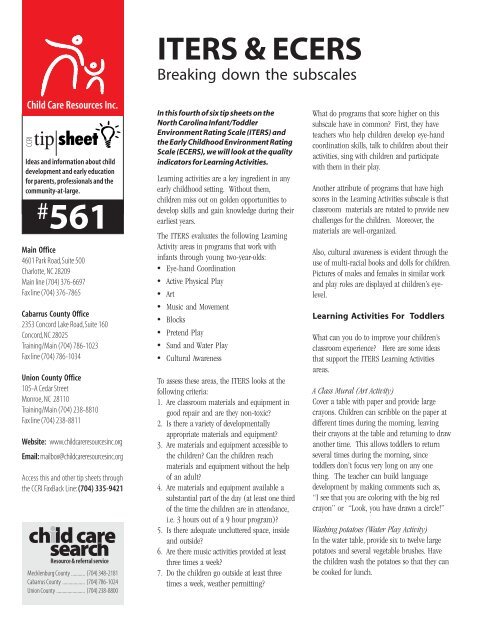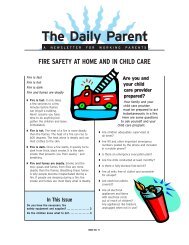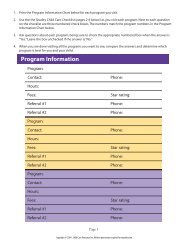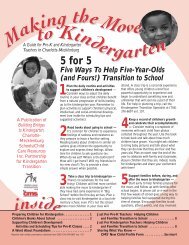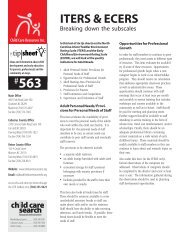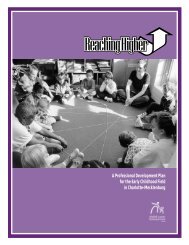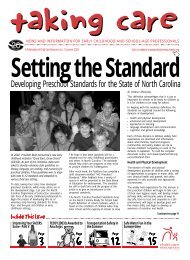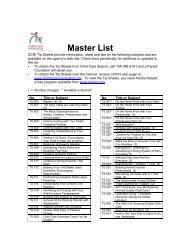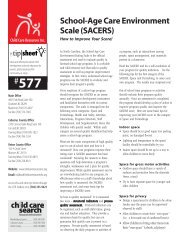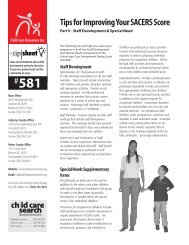ITERS & ECERS - Child Care Resources
ITERS & ECERS - Child Care Resources
ITERS & ECERS - Child Care Resources
Create successful ePaper yourself
Turn your PDF publications into a flip-book with our unique Google optimized e-Paper software.
<strong>ITERS</strong> & <strong>ECERS</strong><br />
Breaking down the subscales<br />
<strong>Child</strong> <strong>Care</strong> <strong>Resources</strong> Inc.<br />
CCRI<br />
Ideas and information about child<br />
development and early education<br />
for parents, professionals and the<br />
community-at-large.<br />
# 561<br />
Main Office<br />
4601 Park Road, Suite 500<br />
Charlotte, NC 28209<br />
Main line (704) 376-6697<br />
Fax line (704) 376-7865<br />
Cabarrus County Office<br />
2353 Concord Lake Road, Suite 160<br />
Concord, NC 28025<br />
Training/Main (704) 786-1023<br />
Fax line (704) 786-1034<br />
Union County Office<br />
105-A Cedar Street<br />
Monroe, NC 28110<br />
Training/Main (704) 238-8810<br />
Fax line (704) 238-8811<br />
Website: www.childcareresourcesinc.org<br />
Email: mailbox@childcareresourcesinc.org<br />
Access this and other tip sheets through<br />
the CCRI FaxBack Line: (704) 335-9421<br />
Resource & referral service<br />
Mecklenburg County ........... (704) 348-2181<br />
Cabarrus County .................. (704) 786-1024<br />
Union County ....................... (704) 238-8800<br />
In this fourth of six tip sheets on the<br />
North Carolina Infant/Toddler<br />
Environment Rating Scale (<strong>ITERS</strong>) and<br />
the Early <strong>Child</strong>hood Environment Rating<br />
Scale (<strong>ECERS</strong>), we will look at the quality<br />
indicators for Learning Activities.<br />
Learning activities are a key ingredient in any<br />
early childhood setting. Without them,<br />
children miss out on golden opportunities to<br />
develop skills and gain knowledge during their<br />
earliest years.<br />
The <strong>ITERS</strong> evaluates the following Learning<br />
Activity areas in programs that work with<br />
infants through young two-year-olds:<br />
• Eye-hand Coordination<br />
• Active Physical Play<br />
• Art<br />
• Music and Movement<br />
• Blocks<br />
• Pretend Play<br />
• Sand and Water Play<br />
• Cultural Awareness<br />
To assess these areas, the <strong>ITERS</strong> looks at the<br />
following criteria:<br />
1. Are classroom materials and equipment in<br />
good repair and are they non-toxic?<br />
2. Is there a variety of developmentally<br />
appropriate materials and equipment?<br />
3. Are materials and equipment accessible to<br />
the children? Can the children reach<br />
materials and equipment without the help<br />
of an adult?<br />
4. Are materials and equipment available a<br />
substantial part of the day (at least one third<br />
of the time the children are in attendance,<br />
i.e. 3 hours out of a 9 hour program)?<br />
5. Is there adequate uncluttered space, inside<br />
and outside?<br />
6. Are there music activities provided at least<br />
three times a week?<br />
7. Do the children go outside at least three<br />
times a week, weather permitting?<br />
What do programs that score higher on this<br />
subscale have in common? First, they have<br />
teachers who help children develop eye-hand<br />
coordination skills, talk to children about their<br />
activities, sing with children and participate<br />
with them in their play.<br />
Another attribute of programs that have high<br />
scores in the Learning Activities subscale is that<br />
classroom materials are rotated to provide new<br />
challenges for the children. Moreover, the<br />
materials are well-organized.<br />
Also, cultural awareness is evident through the<br />
use of multi-racial books and dolls for children.<br />
Pictures of males and females in similar work<br />
and play roles are displayed at children’s eyelevel.<br />
Learning Activities For Toddlers<br />
What can you do to improve your children’s<br />
classroom experience? Here are some ideas<br />
that support the <strong>ITERS</strong> Learning Activities<br />
areas.<br />
A Class Mural (Art Activity)<br />
Cover a table with paper and provide large<br />
crayons. <strong>Child</strong>ren can scribble on the paper at<br />
different times during the morning, leaving<br />
their crayons at the table and returning to draw<br />
another time. This allows toddlers to return<br />
several times during the morning, since<br />
toddlers don’t focus very long on any one<br />
thing. The teacher can build language<br />
development by making comments such as,<br />
“I see that you are coloring with the big red<br />
crayon” or “Look, you have drawn a circle!”<br />
Washing potatoes (Water Play Activity)<br />
In the water table, provide six to twelve large<br />
potatoes and several vegetable brushes. Have<br />
the children wash the potatoes so that they can<br />
be cooked for lunch.
Sheet #TS561<br />
Page 2<br />
Jars and Lids<br />
(Eye-Hand Coordination Activity)<br />
Gather an assortment of unbreakable jars and<br />
lids. Toddlers will enjoy taking off the lids and<br />
putting them back on. This exercise will<br />
increase eye-hand coordination and matching<br />
skills. Objects that are large enough to prevent<br />
swallowing but small enough to fit into some<br />
of the jars can be added for extra interest. The<br />
teacher can facilitate learning by making<br />
comments such as, “You put the small lid on<br />
the small jar” or “What jar do you think this<br />
big lid will fit on?”<br />
The <strong>ECERS</strong> Learning Activities subscale<br />
evaluates programs for 2 ½ year olds to five<br />
year olds. The subscale’s Learning Activity areas<br />
are:<br />
• Fine Motor<br />
• Art<br />
• Music & Movement<br />
• Blocks<br />
• Sand & Water Play<br />
• Dramatic Play<br />
• Nature & Science<br />
• Math/numbers<br />
• Use of TV, video and/or computers<br />
• Accepting Diversity<br />
Note that the <strong>ECERS</strong> uses the same criteria that<br />
are listed on Page 4 for the Infant/Toddler<br />
Environment Rating Scale.<br />
Like the <strong>ITERS</strong>, there are plenty of ways to<br />
achieve high <strong>ECERS</strong> scores in the Learning<br />
Activity area. Here are just a few . . .<br />
• Label shelves to encourage self-help skills.<br />
• Provide materials for three dimensional art<br />
work at least monthly (clay, play dough,<br />
carpentry).<br />
• Encourage children’s creativity through<br />
open-ended activities: art projects, childcreated<br />
dances and songs, dramatic play<br />
and block play.<br />
• Provide sand and water play at least one<br />
hour each day.<br />
• If computers are available, use them as one<br />
of many free choice activities.<br />
• Provide activities that promote understanding<br />
and acceptance of diversity.<br />
Learning Activities For Two’s to<br />
Five’s<br />
The Blowing Game (Science Activity)<br />
With two and three year olds<br />
Place a variety of small objects on a large<br />
piece of construction paper. Ask the children<br />
to blow the objects off the construction paper.<br />
<strong>Child</strong>ren will have great fun blowing a<br />
variety of objects off the paper (i.e. paper cup,<br />
crayon, spool, toilet paper roll, a block, small<br />
car, etc.). The teacher observes the children’s<br />
efforts and asks thought provoking questions<br />
such as, “Why do you think that you weren’t<br />
able to blow the block off the paper?<br />
With four and five year olds<br />
Place objects of various weights on a large<br />
sheet of construction paper. Ask the children<br />
to guess what objects they think they can<br />
blow off the paper. The teacher can extend<br />
the learning by asking questions such as,<br />
“Why do you think you can not blow off the<br />
block?” After the children have made their<br />
predictions, then they can test their predictions<br />
by trying to blow off the objects.<br />
Grocery store (Dramatic Play Activity)<br />
Change your housekeeping area into a grocery<br />
store. Provide empty cans (with the rough<br />
edges smoothed off), empty food boxes, pretend<br />
fruits and vegetables, paper bags, small carts,<br />
dolls, cash register, play money, paper and<br />
markers to make signs, scale, aprons, etc. Be<br />
sure to provide ethnic food boxes and cans.<br />
Color Drop & Mix (Fine Motor Activity)<br />
Place an ice tray on a cafeteria tray. In<br />
three of the ice tray compartments, place<br />
red, blue and yellow food color (a<br />
different color in each compartment). In<br />
the other compartments, place clear<br />
water. Provide several eye droppers so that<br />
children can mix the food color and see<br />
what colors they can make. Also, provide<br />
coffee filters onto which children to drop<br />
the mixed color. Protective aprons are<br />
recommended. This activity can also be<br />
an art project.<br />
Summing It Up<br />
Achieving a high score on the <strong>ITERS</strong> and<br />
<strong>ECERS</strong> Learning Activity subscale may<br />
seem like a dream (and a lot of work),<br />
but there really are plenty of ways to do it.<br />
Follow some of these above suggestions<br />
and see how quickly and easily your<br />
children are engaged in stimulating,<br />
hands-on learning activities. And watch<br />
your scores go up!


